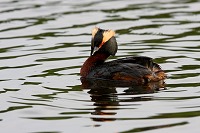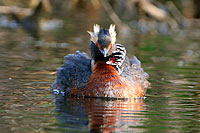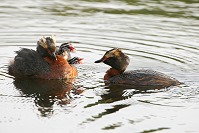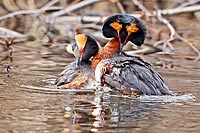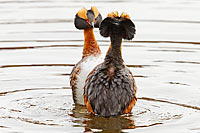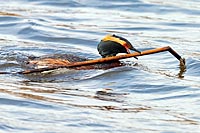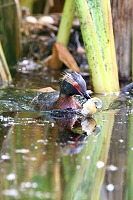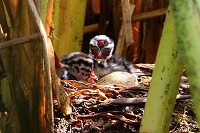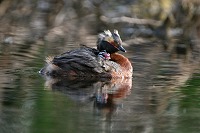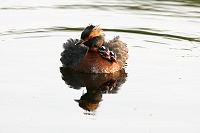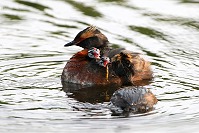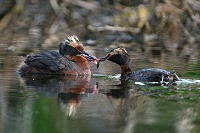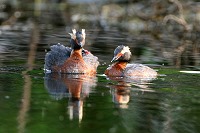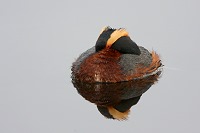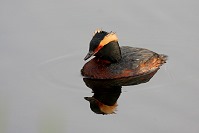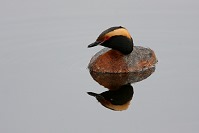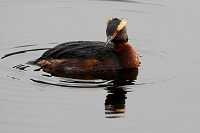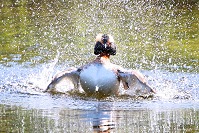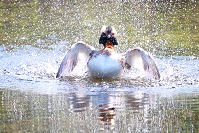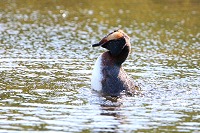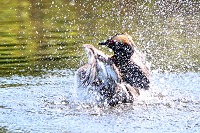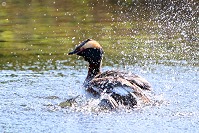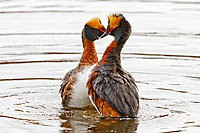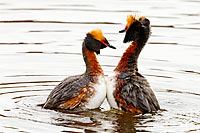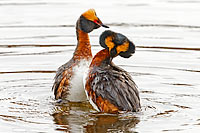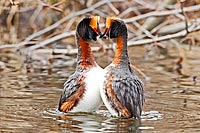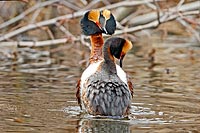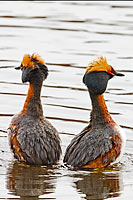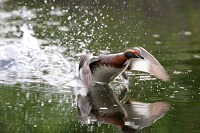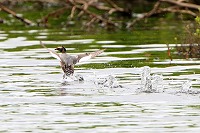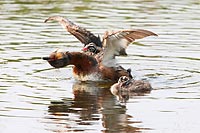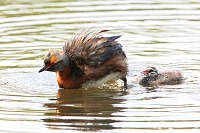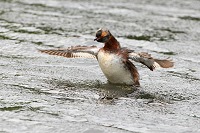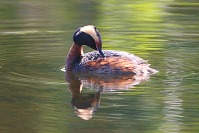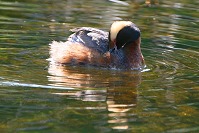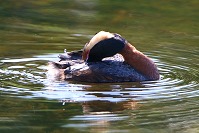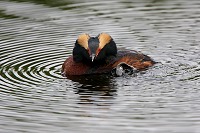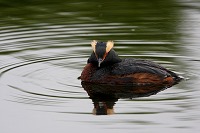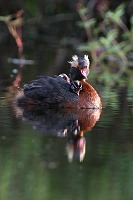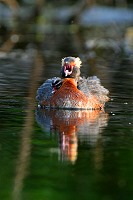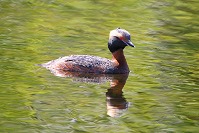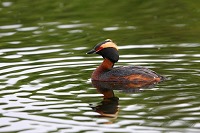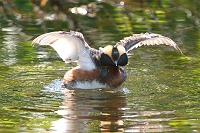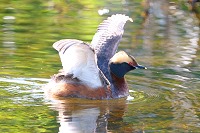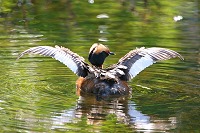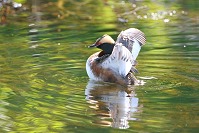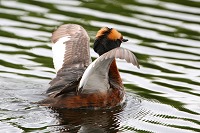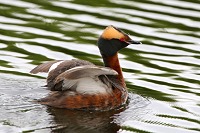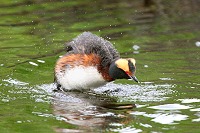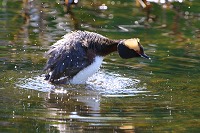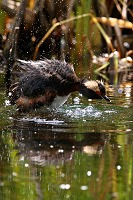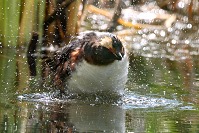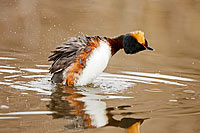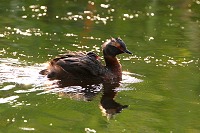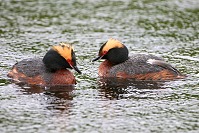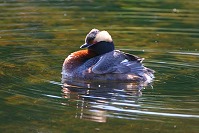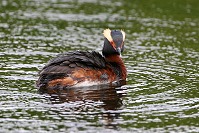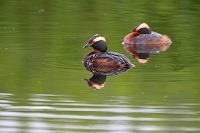 |
~ HORNED GREBES in ALASKA ~
| |
|
The Horned Grebe is among the smaller members of the Grebe family. At only 10 to 15 inches in length, it is much smaller than its
cousin, the Red-Necked Grebe which is also found in Alaska.
Grebes are migratory water birds who leave their wintering grounds in the Southern United States to breed in Canada and Alaska during the summer.
Horned Grebes are also found in Europe and Asia.
|
|
|
|
|
Common Names:
Scientific Name:
|
Horned Grebe, Slavonian Grebe
Podiceps auritus
|
Class:
Diet:
|
Aves (Birds)
Small fish, aquatic insects
|
Range:
Migratory:
|
North America, Europe, Asia
Yes
|
Length:
Wingspan:
Weight:
|
12 to 15 inches
20 to 25 inches
Approx. 1 pound
|
| |
During the Winter, Horned Grebes have a dull black and white plumage, but during the breeding season, they display a more striking
color scheme with a reddish chest and yellow feathery horns on the side of the head. Males and females have the same plumage, but males are slightly bigger.
|
|
|
|
|
|
|
In between their dance ritual, the Horned Grebes begin to gather building material for their nest, such as straws and roots.
Grebe Weed Dance
 |
|
|
Female Horned Grebes usually lay 2 to 5 eggs in June, and raise just one brood each year. For a period of 3 to 4 weeks, both parents take
turns incubating the eggs.
Photo at right: A third egg has just hatched. Two more eggs can still be seen in the nest on the upper left part of the picture.
This brood has a total of 5 eggs in the nest.
Soon after the eggs have hatched, the parents carefully dispose of the egg shells far away from the nest to keep predators away.
|
|
|
|
|
|
|
|
Photo at left: The two chicks in this picture are just a few days old. A third chick is out of sight. One unhatched egg is clearly visible, and another one (hidden) is to the left.
With this lovely brood of five, only two chicks will make it to the next phase, out of the nest and on the parents' back ...
|
|
|
|
|
|
Being excellent swimmers, Horned Grebes dive underwater to catch small fish, crustaceans and water bugs.
The chicks, with black and white stripes, hitch a ride on one of the parents' back, and patiently wait for the other parent to bring food to the table.
|
|
A Horned Grebe resting and enjoying a peaceful moment in the marsh late in the evening. The glassy surface of the water gives off a nice reflection.
|
|
|
|
|
|
|
|
|
Never a dull moment watching the Grebes. This Horned Grebe makes quite an impression by fiercely splashing the water with its wings.
|
|
|
Hungry for attention, the Grebe now shows off its best profile.
|
|
|
|
|
|
|
Horned Grebe Dance Ritual |
|
|
To initiate the dance ritual, the Horned Grebes start to call each other. After they come into position, face to face, their head feathers begin to flare out
to the side. As they quickly paddle their feet in the water, the Horned Grebes thrust their chest against each other while bobbing their head up and down.
|
|
|
|
|
Grebe Dance
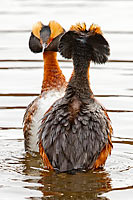 |
|
|
|
|
|
|
|
This part of the dance ritual usually only lasts less than a minute. Immediately afterwards, the Horned Grebe couple performs a "weed dance" where they dive
into the water in unison and bring back weed in their beak to build their nest.
|
|
|
Right: Horned Grebes running on the surface of the water before taking off.
Bottom: Stretching their wings and fluffing their feathers.
|
|
|
|
|
|
Attending to their Feathers |
|
|
|
|
|
|
Horned Grebes are water birds, often diving under water to gather food, and therefore, they must take good care of their plumage. They
are seen preening their feathers in these pictures.
|
|
Pictures of Horned Grebes taken during the Summer months.
Right: Grebe photographed in an unusual position makes it look meaner than it really is.
|
|
|
|
|
|
|
This Horned Grebe fluffs its wings like a water ballet dancer. The reflection on the surface of the water makes for a beautiful pastel backdrop.
The underside of the wings is white.
|
|
|
|
|
Once in a while, Horned Grebes suddenly shake their whole body. It is believed this is to rearrange their feathers. This behaviour also occurs when other
Grebes pass nearby.
|
|
|
|
|
|
|
|
|
|
|
Horned Grebes photographed in the evening light.
|
Go to the Moon & Get the Best Pictures
...Smile... ' Click! '

[email protected]
© Copyright Go2Moon, Alaska


